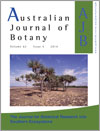Australian Journal of Botany
Volume 62
Number 5 2014
The research reports on the salinity-tolerance mechanism of two species, namely, cropped (S. lycopersicum) and wild (S. chilense) tomato. This study compares the physiological response to salt stress, demonstrating that the wild species copes better with salinity than does the cropped tomato. Our work elucidates the advantages of wild tomato to successfully grow in saline conditions and the potential manipulation by plant breeding of the cropped tomato.
Intervals between fires are critical for the persistence of obligate-seeding shrubs, yet information about reproductive trajectories is limited. Measurements of flowering and fruiting for eight obligate-seeding shrubs at sites in south-eastern Australia were modelled in relation to time-since-fire, and times to reach 80% maximum flower production varied from 5 to 18 years post-fire. The results extend knowledge about reproductive maturation of plant species, which is used in ecological fire planning.
Significant increases of exotic vascular plant species on Moreton Island, Australia, can have an adverse impact on the native biodiversity. From virtually no exotic species to 120 over the past century, this research aimed to assess those exotic life forms and their invasive potential to spread on the island. The findings highlight the need to understand the dynamics of exotic species and to achieve more effective weed management and native species conservation.
The closest living relatives of that vastly important plant family, the grasses (Poaceae), are three species of plant family Ecdeiocoleaceae, all in Western Australia. Observations of their flowering show that separate zones of male and female flowers in each of the many spikes on a plant open synchronously: all female with conspicuous white stigmas or all male with yellow anthers. This unusual synchronous flowering gives these wind-pollinated plants a unique and effective out-crossing breeding system.
The relationship between scales and stomata may explain a major water conservation mechanism in tropical, mountain Rhododendron species. There was a negative relationship between leaf scales and stomatal pore area among accessions representing 83 species. These results provide the first test of the functional significance of scales to water conservation at mid-elevation in tropical, mountain evergreen plants.
Many Australian native plant species, such as the sedge Gahnia radula, are not available for revegetation because of the lack of efficient propagation methods. This research comprised the assessment of seed germination, micropropagation, nursery division, flower structure, fungal associations through to field planting. Through the use of tissue culture, this keystone species is now becoming available for the first time for revegetation projects.
Ecosystems that rely on a supply of groundwater are of global importance but are rarely studied in mesic climates because it is assumed that groundwater supply is only important in arid or semi-arid climates. This study examined structural attributes of eucalypt woodlands along a naturally occurring gradient in depth-to-groundwater and shows that these attributes are strongly affected by depth-to groundwater, with an apparent cut-off in access to groundwater occurring at a depth of 8–10 m. These results will inform water-resource managers in the limits to groundwater extraction.
This research highlights contrasting ancestral demography according to spatial and temporal environmental change. We investigate population expansion–contraction histories and ancestral migration patterns to explore the impact of climate change on long-lived foundation species. This information is important in understanding the evolutionary processes responsible for high diversity and narrow endemism, and shows the potential vulnerability of these populations-species-communities to future threats in the context of past demographic trends.




